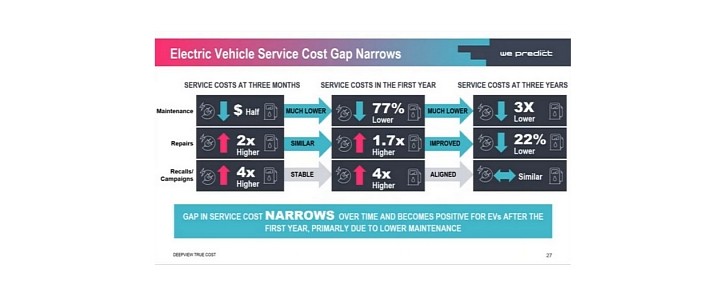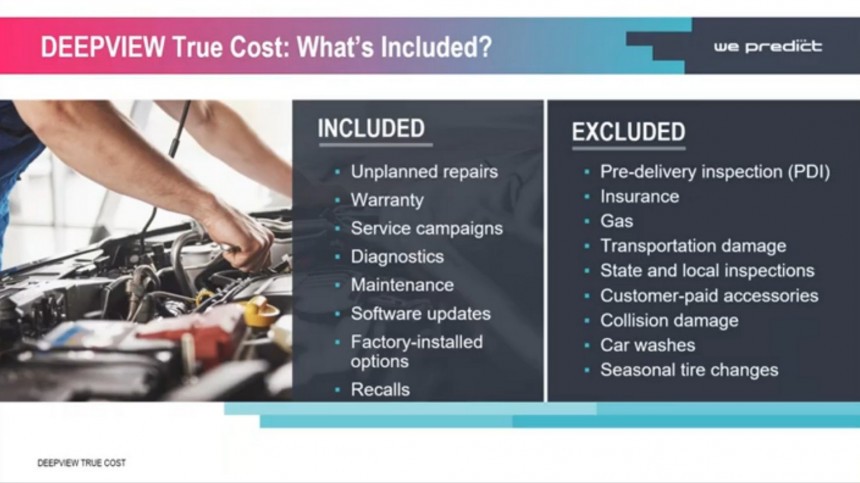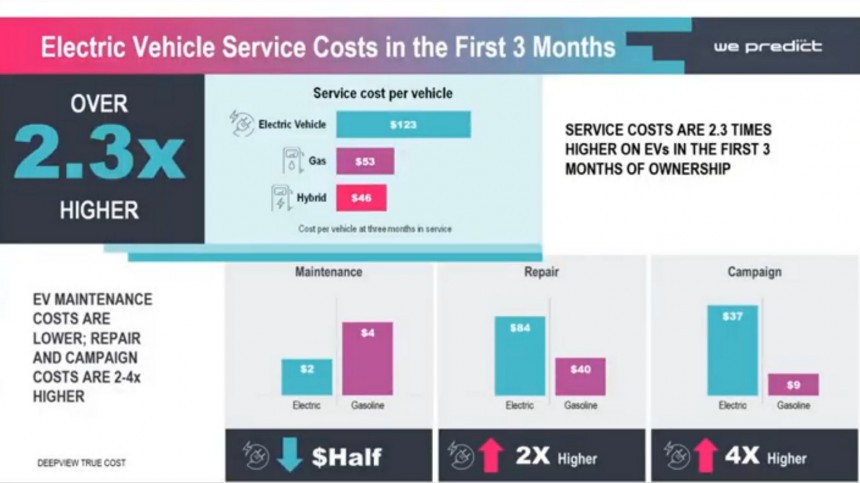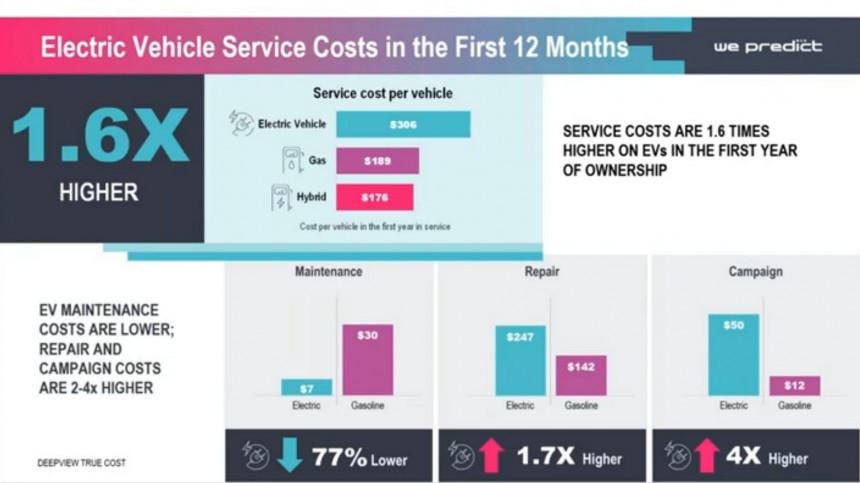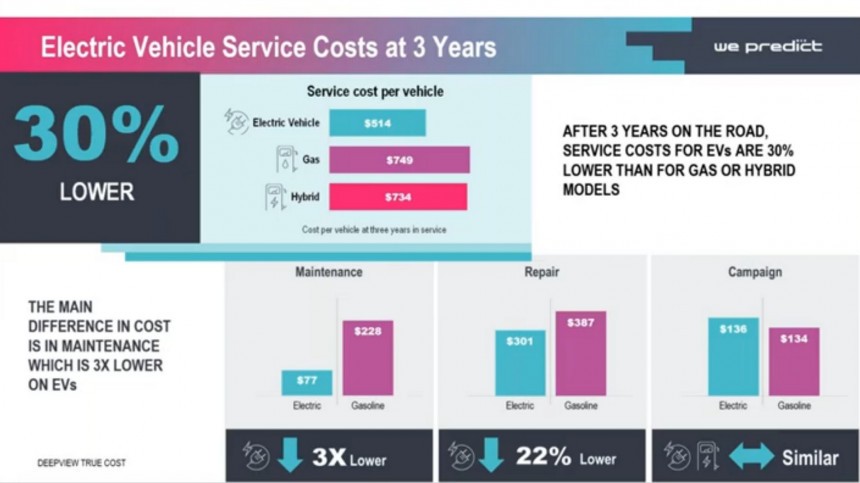You must have already heard multiple times that EVs are cheaper to keep than ICE cars. Not having oil changes, spark plugs, belts, and other wear components make that seem an obvious conclusion. Thankfully, a company called We Predict created the Deepview True Cost SOS (Second Owner Study) and gave us a new perspective on that.
Summing up, what We Predict discovered was that the costs of EVs in the first year were 62% higher ($306 versus $189) than those of combustion-engined cars. That situation is inverted after three years when ICE vehicle costs turn 45.7% higher ($749 against $514) than those of electric cars. However, starting with the summary is a way not to stick with this conclusion. There are other elements presented by the study that deserves much more of your attention.
First of all, it is essential to understand what We Predict defines as true costs. The company did not restrict its analysis to what customers spend. It went after the “total money spent by manufacturers and vehicle owners on repairs, maintenance, service campaigns, diagnostics, software updates, recalls, and warranty on factory-installed options.” In other words, it included what carmakers also spend with their products.
You may say, “what do I care” for corporation expenses, but these costs may eventually fall on customers' shoulders when the warranty expires. That said, the least money any vehicle requires – regardless of who is paying the bill – is a good measurement of how much it will charge from second owners. That’s the reason for the study's name.
We Predict excluded costs with gas and recharging. Energy efficiency is a significant advantage of electric vehicles, but costs may vary a lot depending on how much people drive and where. That said, we understand why the company preferred not to count them. If that benefits ICE vehicles, We Predict also decided not to calculate tire bills. Being heavier, electric cars wear out more tires during their lifetimes. In other words, that may end up being fair for both kinds of automobiles.
The study breaks down the expenses into three major categories: maintenance, repairs, and service campaigns. We are not sure if service campaign costs include recalls, for example, but we suspect they don’t. Stick with us to understand why.
When it comes to maintenance, electric cars are always less expensive than ICE vehicles. In the first three months, combustion-engined car costs are 100% higher ($4 against $2). After one year, the ICE vehicle expenses reach $30. Those for EVs more than triple in value... getting to $7. That means combustion-engined vehicles costs are 328% higher than those of electric cars. After three years, EV maintenance will have demanded $77, while ICE cars will require an average of $228, or 196% more.
What makes EV more expensive in the first year are repairs and service campaigns. Repairs are costlier because they are so new to most companies. That makes them spend twice as much time in average diagnosis hours than ICE vehicles. Technicians want to be sure they are getting these cars fixed right. Therefore, they spend more time in contact with the factories and talking to other specialists about the issues.
Electric cars also demand more labor hours to get things repaired: 1.5 times more on average. Finally, the labor rate for EV technicians is 1.3 times more expensive than those of people fixing an ICE vehicle.
We Predict also checked which are the most common repairs done to electric cars. The leading cause of problems with them is battery chargers and cables, followed by battery packs. Those elements are unique to EVs, such as battery contacts (in fourth place), high voltage wiring (in seventh), and battery control units (in eighth). All other issues with EVs relate to components combustion-engined cars also have.
Battery packs are a very expensive component in electric vehicles. Any issue with them would make repair prices skyrocket. Recalls on them would also be reflected in the true cost. Yet, We Predict’s study does not seem to reflect that. The Chevrolet Bolt EV got second place in its rating despite the mega recall in which it is involved. This is why we don’t think the study considers recalls in the safety campaign costs.
Despite that, repair and safety campaign costs with EVs are respectively 74% ($247 versus $142) and 317% ($50 against $12) higher than those of ICE vehicles after the first year. The game only changes in the third year, when repair costs for EVs reach $301. Compared to the $387 spent on automobiles with combustion engines, that’s 28.6% lower. The safety campaign expenses in the third year were $136 for EVs and $134 for ICE cars. We Predict decided they were too close to consider any of them was higher than the other.
All things considered, the Deepview True Cost SOS showed us that EVs eventually get less costly after three years. However, that does not mean much. Being a recent technology makes them have higher repair and service campaign costs. As time goes by and electric cars get more popular, these costs should drop to the point that EVs are apparently cheaper than ICE cars.
We say "apparently" because issues with the battery pack can easily make them much more expensive than vehicles with a combustion engine. Suppose battery suppliers have any production issues such as the ones LGES (LG Energy Solution) so far had with the Hyundai Kona Electric and Chevrolet Bolt EV. In that case, EVs may suddenly have higher costs.
You may reason that a manufacturing defect with engines would also be costly. Indeed, but they would not be even close to those related to large battery packs. The least expensive units cost around $10,000. Some can reach $20,000, as a recent case with a Tesla Model 3 made clear.
Summing up again, the study misses a crucial word in its conclusion. It would be bullet-proof if it said that EVs are potentially cheaper after three years. The truth is that it depends. A more comprehensive study – with older electric vehicles in need of a battery pack replacement – would probably make ICE vehicles look more affordable. With decarbonization efforts at full steam, that does not mean they are still an option. On the contrary: it shows we need to make better efforts to electrify transportation means.
To make EVs popular, we need better and more reliable batteries. If they are not yet possible, we need to invest in fuel cells and a hydrogen network, which may still be the best options for heavy vehicles. Even with better batteries, we have to make sure there will be enough raw materials to build them. Without that, any cost estimate, as competent and complete as it may be, will be provisory.
First of all, it is essential to understand what We Predict defines as true costs. The company did not restrict its analysis to what customers spend. It went after the “total money spent by manufacturers and vehicle owners on repairs, maintenance, service campaigns, diagnostics, software updates, recalls, and warranty on factory-installed options.” In other words, it included what carmakers also spend with their products.
You may say, “what do I care” for corporation expenses, but these costs may eventually fall on customers' shoulders when the warranty expires. That said, the least money any vehicle requires – regardless of who is paying the bill – is a good measurement of how much it will charge from second owners. That’s the reason for the study's name.
The study breaks down the expenses into three major categories: maintenance, repairs, and service campaigns. We are not sure if service campaign costs include recalls, for example, but we suspect they don’t. Stick with us to understand why.
When it comes to maintenance, electric cars are always less expensive than ICE vehicles. In the first three months, combustion-engined car costs are 100% higher ($4 against $2). After one year, the ICE vehicle expenses reach $30. Those for EVs more than triple in value... getting to $7. That means combustion-engined vehicles costs are 328% higher than those of electric cars. After three years, EV maintenance will have demanded $77, while ICE cars will require an average of $228, or 196% more.
Electric cars also demand more labor hours to get things repaired: 1.5 times more on average. Finally, the labor rate for EV technicians is 1.3 times more expensive than those of people fixing an ICE vehicle.
We Predict also checked which are the most common repairs done to electric cars. The leading cause of problems with them is battery chargers and cables, followed by battery packs. Those elements are unique to EVs, such as battery contacts (in fourth place), high voltage wiring (in seventh), and battery control units (in eighth). All other issues with EVs relate to components combustion-engined cars also have.
Despite that, repair and safety campaign costs with EVs are respectively 74% ($247 versus $142) and 317% ($50 against $12) higher than those of ICE vehicles after the first year. The game only changes in the third year, when repair costs for EVs reach $301. Compared to the $387 spent on automobiles with combustion engines, that’s 28.6% lower. The safety campaign expenses in the third year were $136 for EVs and $134 for ICE cars. We Predict decided they were too close to consider any of them was higher than the other.
All things considered, the Deepview True Cost SOS showed us that EVs eventually get less costly after three years. However, that does not mean much. Being a recent technology makes them have higher repair and service campaign costs. As time goes by and electric cars get more popular, these costs should drop to the point that EVs are apparently cheaper than ICE cars.
You may reason that a manufacturing defect with engines would also be costly. Indeed, but they would not be even close to those related to large battery packs. The least expensive units cost around $10,000. Some can reach $20,000, as a recent case with a Tesla Model 3 made clear.
Summing up again, the study misses a crucial word in its conclusion. It would be bullet-proof if it said that EVs are potentially cheaper after three years. The truth is that it depends. A more comprehensive study – with older electric vehicles in need of a battery pack replacement – would probably make ICE vehicles look more affordable. With decarbonization efforts at full steam, that does not mean they are still an option. On the contrary: it shows we need to make better efforts to electrify transportation means.
To make EVs popular, we need better and more reliable batteries. If they are not yet possible, we need to invest in fuel cells and a hydrogen network, which may still be the best options for heavy vehicles. Even with better batteries, we have to make sure there will be enough raw materials to build them. Without that, any cost estimate, as competent and complete as it may be, will be provisory.
